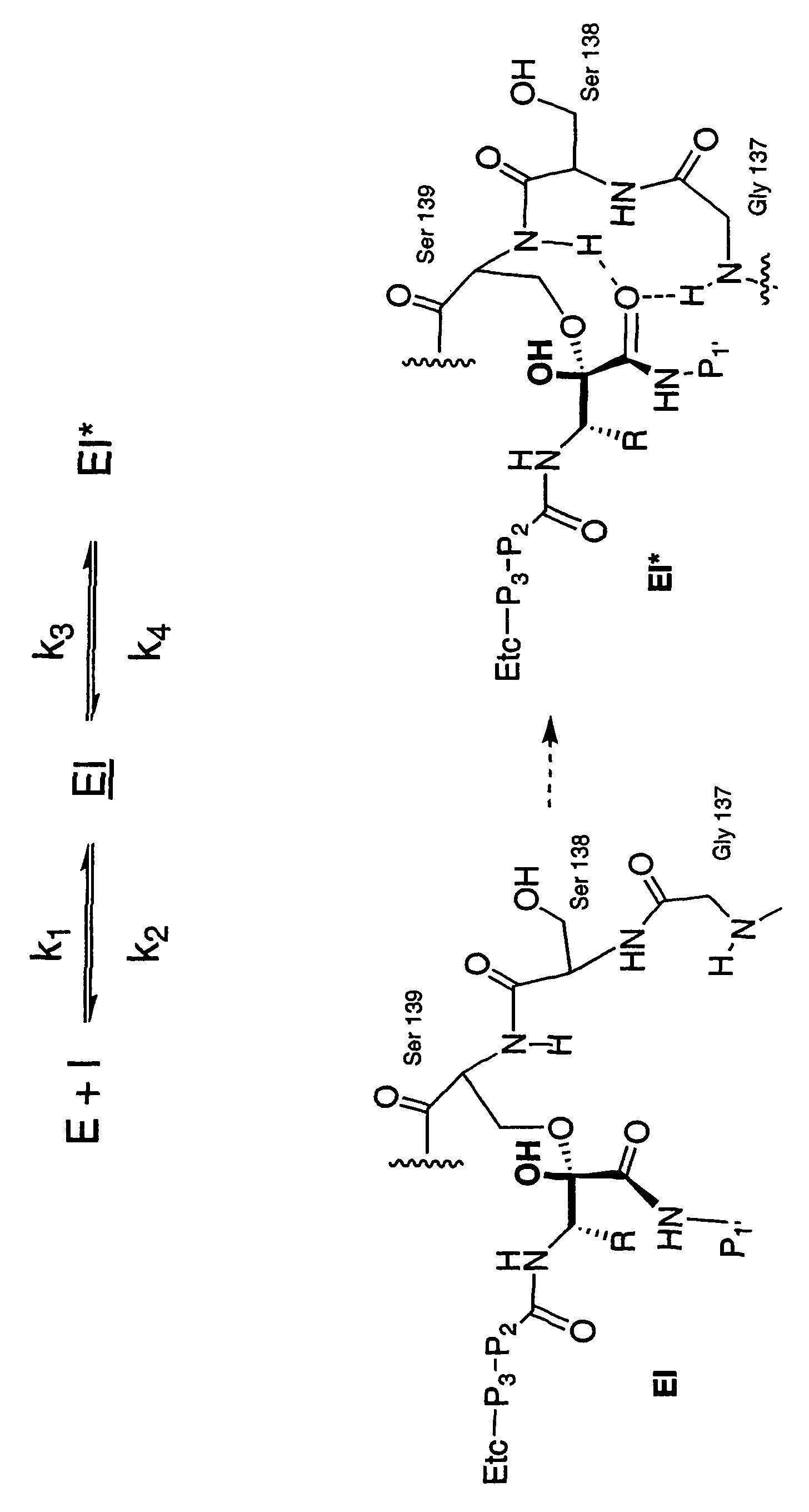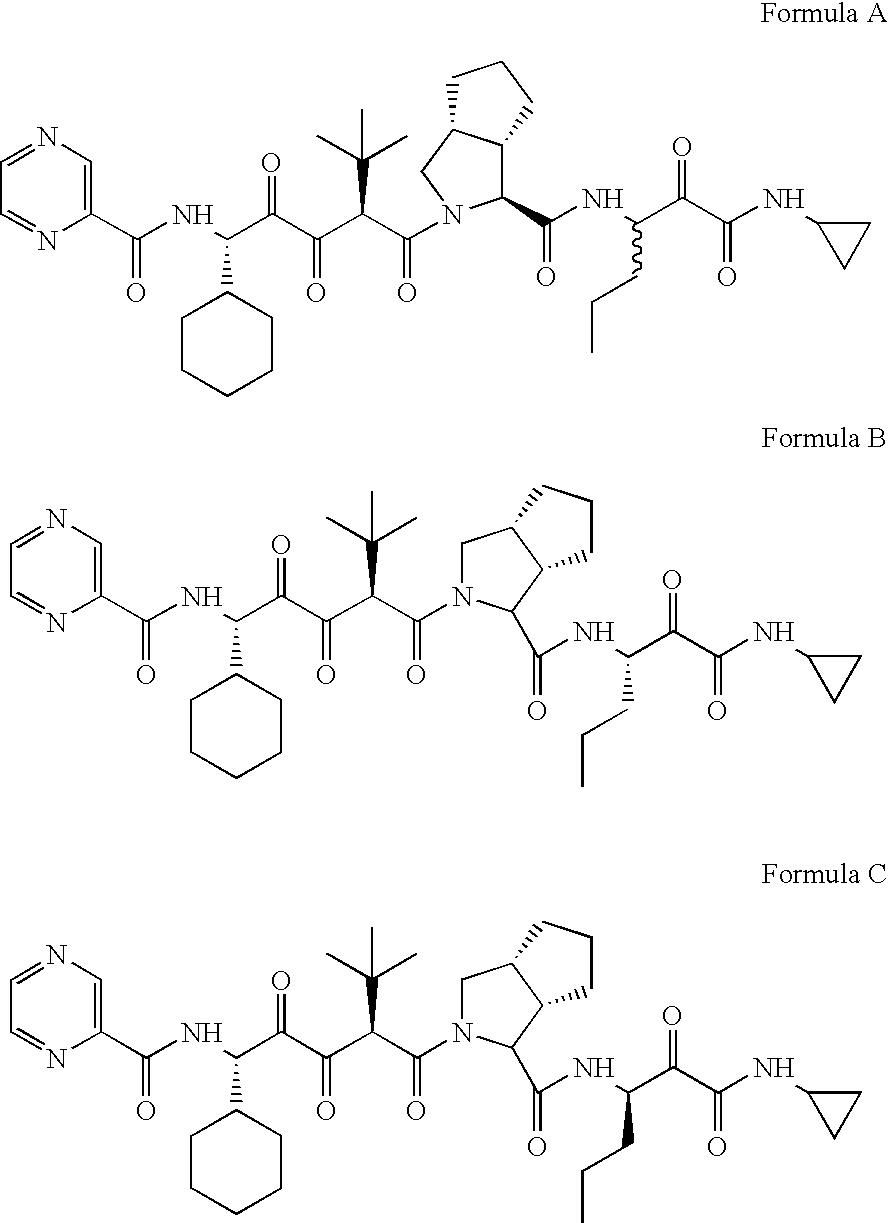Drug discovery method
a discovery method and compound technology, applied in the field of compound discovery methods, can solve the problems of time and a tremendous commitment of company resources, and achieve the effect of reducing or eliminating hcv contamination
- Summary
- Abstract
- Description
- Claims
- Application Information
AI Technical Summary
Benefits of technology
Problems solved by technology
Method used
Image
Examples
example 1
[0113]The rates of onset of slow binding inhibition were determined by a modification of the method for measurement of progress curves described in Narjes et. al. (2000).
[0114]Enzyme activity was measured using a continuous assay which monitored the increase of fluorescence which resulted from cleavage of the internally quenched fluorogenic depsipeptide (FRET substrate):
[0115]Ac-Glu-Asp-Glu-(Edans)-Asp-Asp-Aminobutyrl-ψ[COO]-Ala-Ser-Lys -(Dabcyl)-NH2 (SEQ ID NO: 1)
In the Sequence Listing
[0116]Please introduce the computer-readable form of the Sequence Listing (filename: 40506_SeqListing.txt) submitted herewith as part of the application as filed.
[0117]Two hundred nanomolar NS3 (protease domain) was pre-incubated for 10-15 minutes at room temperature in 50 mM HEPES, pH 7.5, 25 μM KK4A and 5 mM dithiothreitol (DTT). An aliquot of this mixture was then added to 50 mM HEPES, pH 7.5, 15% v / v glycerol, 25 μM KK4A and 5 mM dithiothreitol containing 4 μM to 8 μM FRET peptide substrate (4-8×...
example 2
[0129]Cells containing subgenomic HCV RNA (replicon) are maintained in DMEM containing 10% fetal bovine serum (FBS), 0.25 mg / ml of G418. On the day prior to the assay, 104 HCV replicon cells were plated in each well of a 96-well plate in the presence of 10% FBS but no G418 to allow the cells to attach and to grow overnight (˜16 h). On the day of the assay, the culture media were removed and replaced with media with serially diluted compounds in the presence of 2% FBS and 0.5% DMSO. The replicon cells were treated with the compound for 48 hours, then the reduction of HCV RNA in the cells was determined by quantitative RT-PCR (Taqman) and the cytotoxicity of the compound was determined by MTS-based cell viability assay. The IC50 and CC50 of the compound were calculated from these assays using 4-parameter curve fitting. IC50 represents the concentration of the compound at which the HCV RNA level in the replicon cells is reduced by 50%. CC50 represents the concen...
example 3
9-Day Viral Clearance (VC) Assay
[0130]The replicon cells were plated at a very low density (500 cells per well) in a 96-well plate so that they won't reach confluence after 9 days in culture. Compounds were serially diluted to concentrations at multiples (2×, 5×, etc.) of their respective IC50's in media containing 10% FBS and 0.2% DMSO. The media containing compounds were replaced every three days. The cells were treated with compounds for 3, 6 or 9 days. At the end of experiment, cell numbers were determined in an MTS-based assay with an established standard curve, the level of HCV RNA in the cells was measured by quantitative RT-PCR (Taqman), and then the copy number of HCV replicon RNA per cell in each sample was calculated.
PUM
| Property | Measurement | Unit |
|---|---|---|
| periods of time | aaaaa | aaaaa |
| pH | aaaaa | aaaaa |
| pH | aaaaa | aaaaa |
Abstract
Description
Claims
Application Information
 Login to View More
Login to View More - R&D
- Intellectual Property
- Life Sciences
- Materials
- Tech Scout
- Unparalleled Data Quality
- Higher Quality Content
- 60% Fewer Hallucinations
Browse by: Latest US Patents, China's latest patents, Technical Efficacy Thesaurus, Application Domain, Technology Topic, Popular Technical Reports.
© 2025 PatSnap. All rights reserved.Legal|Privacy policy|Modern Slavery Act Transparency Statement|Sitemap|About US| Contact US: help@patsnap.com



